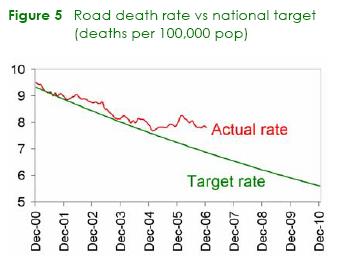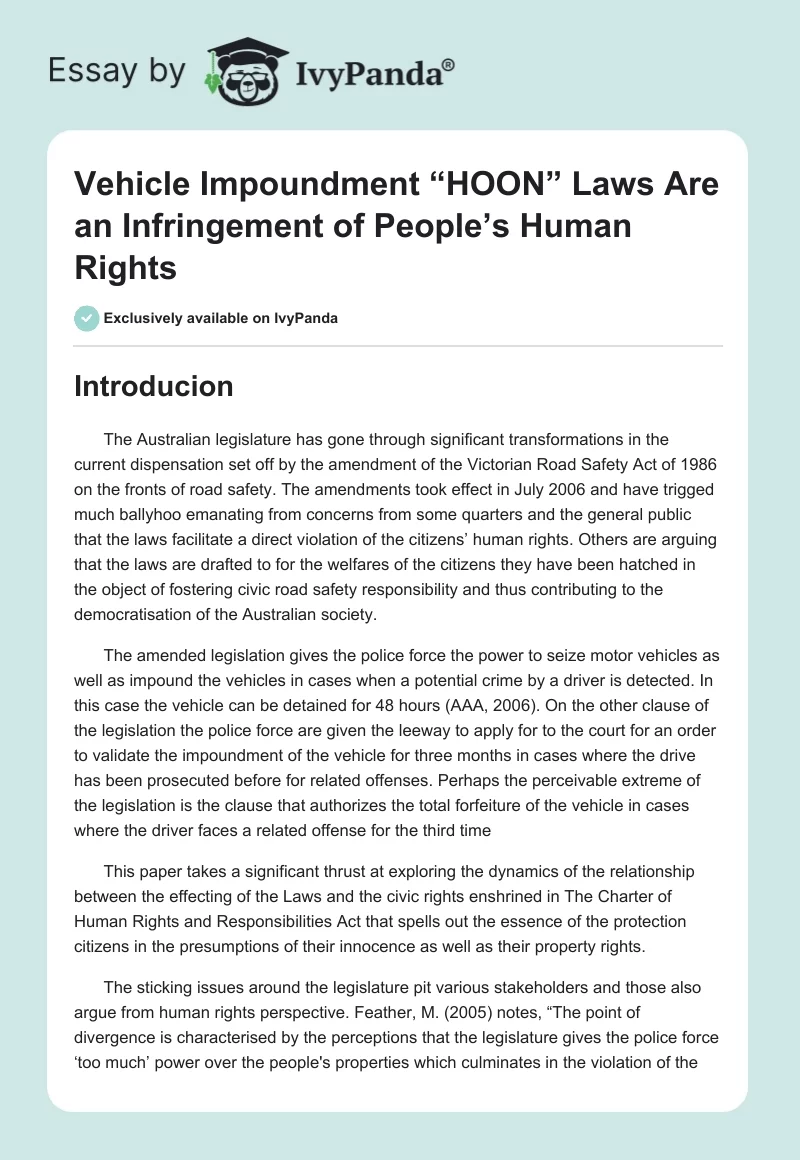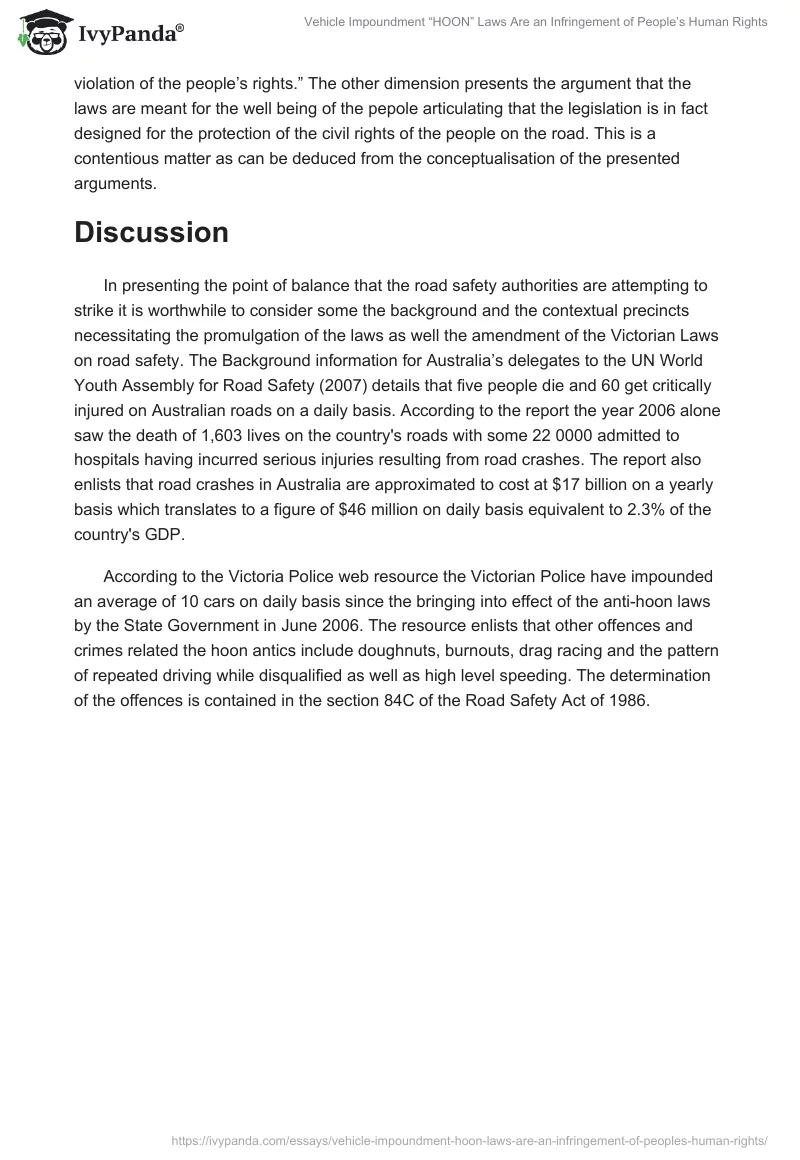Introducion
The Australian legislature has gone through significant transformations in the current dispensation set off by the amendment of the Victorian Road Safety Act of 1986 on the fronts of road safety. The amendments took effect in July 2006 and have trigged much ballyhoo emanating from concerns from some quarters and the general public that the laws facilitate a direct violation of the citizens’ human rights. Others are arguing that the laws are drafted to for the welfares of the citizens they have been hatched in the object of fostering civic road safety responsibility and thus contributing to the democratisation of the Australian society.
The amended legislation gives the police force the power to seize motor vehicles as well as impound the vehicles in cases when a potential crime by a driver is detected. In this case the vehicle can be detained for 48 hours (AAA, 2006). On the other clause of the legislation the police force are given the leeway to apply for to the court for an order to validate the impoundment of the vehicle for three months in cases where the drive has been prosecuted before for related offenses. Perhaps the perceivable extreme of the legislation is the clause that authorizes the total forfeiture of the vehicle in cases where the driver faces a related offense for the third time
This paper takes a significant thrust at exploring the dynamics of the relationship between the effecting of the Laws and the civic rights enshrined in The Charter of Human Rights and Responsibilities Act that spells out the essence of the protection citizens in the presumptions of their innocence as well as their property rights.
The sticking issues around the legislature pit various stakeholders and those also argue from human rights perspective. Feather, M. (2005) notes, “The point of divergence is characterised by the perceptions that the legislature gives the police force ‘too much’ power over the people’s properties which culminates in the violation of the violation of the people’s rights.” The other dimension presents the argument that the laws are meant for the well being of the pepole articulating that the legislation is in fact designed for the protection of the civil rights of the people on the road. This is a contentious matter as can be deduced from the conceptualisation of the presented arguments.
Discussion
In presenting the point of balance that the road safety authorities are attempting to strike it is worthwhile to consider some the background and the contextual precincts necessitating the promulgation of the laws as well the amendment of the Victorian Laws on road safety. The Background information for Australia’s delegates to the UN World Youth Assembly for Road Safety (2007) details that five people die and 60 get critically injured on Australian roads on a daily basis. According to the report the year 2006 alone saw the death of 1,603 lives on the country’s roads with some 22 0000 admitted to hospitals having incurred serious injuries resulting from road crashes. The report also enlists that road crashes in Australia are approximated to cost at $17 billion on a yearly basis which translates to a figure of $46 million on daily basis equivalent to 2.3% of the country’s GDP.
According to the Victoria Police web resource the Victorian Police have impounded an average of 10 cars on daily basis since the bringing into effect of the anti-hoon laws by the State Government in June 2006. The resource enlists that other offences and crimes related the hoon antics include doughnuts, burnouts, drag racing and the pattern of repeated driving while disqualified as well as high level speeding. The determination of the offences is contained in the section 84C of the Road Safety Act of 1986.

The figure above is a graphical representation of road death rates by age groups in 2006 as detailed in The Background information for Australia’s delegates to the UN World Youth Assembly for Road Safety (2007).

Discussion graphic
The graph above displays the road deaths rate in comparison to the national target as entailed in The Background information for Australia’s delegates to the UN World Youth Assembly for Road Safety (2007).
Various reasons have been offered by the road safety authorities to explicate why the plans to curtail the road carnages are falling behind the national targets. “Some of the reasons include that the number of kilometers traveled on roads has always come out higher than that expected and that with an exception of Victoria speed regulation improvements have been incremental” (Feather, M. 2005) One of the salient reasons cited is that the development of the road network infrastructure has been kept relatively constant whilst greater investment are required to obtain betty results.
The legislation
The foregoing has contributed to the entire factorial paradigm that validates the implementation of the Victorian legislature as complementary means to curtail the road carnage. The legislation has been implemented in the consideration that drivers who behave with criminal disregard of road safety regulations have to face tougher measures that will at least suffice to reduce the rate of road accidents caused by typically criminal conduct on the roads. The concept behind the implementation of the contentious legislation is encapsulated in eth statement extracted from The Background information for Australia’s delegates to the UN World Youth Assembly for Road Safety (2007), “safety can be embedded into the system in a comprehensive and systemic manner and not just applying stop-gap measures and just going as far the scope of the apparent problem”
The social relevance of the Anti-Hoon legislation can be drawn from the fact that regulation is aimed at deterring the committing of offences such as excess noise, street racing and cases like refusal to vacate public places and also the cases of exhibitions of acceleration as well as burnouts. It can be said that the relevance of the legislature is based on the fact that the laws are tailored to protect a people’s more serious and critical road rights and liberties.
Perhaps some statistics drawn from Victoria published in The Background information for Australia’s delegates to the UN World Youth Assembly for Road Safety (2007) highlight the effectiveness of the implementation. The report details that in Victoria a n average of almost five vehicles a day get impounded since the implementation of the laws in July 2006. The police crash studies have also indicated according to the report that hoon driving led to 41 serious crashes in the period between January 2003 and November 2004 which resulted in 28 deaths.
Many arguments leveled against the Victorian Road Safety laws have been premised in the context of human rights. Human rights are the foundational framework for the definition of the human welfare central aspects of freedom, justice, peace and integrity as well as the critical part of democratic and open human societies that considers the law, human dignity and equity. The charters of human rights come with various entitlements on the dimensions of economic as well as social rights, civil and political rights and also the environmental and cultural rights. The salient point that dominates contention against the Victorian Road Safety Regulations borders on the misconception that the confiscation of the individuals’ vehicle is a breach of people’s rights over their property. People need to apply a contextual and conceptual interpretation of the law on this matter.
Although arguments abound that the legislation is implemented in direct violation of Human rights detailed in the Victorian Charter which entails that a person charged with crime possesses the right to be held as innocent until prove guilty, it is important to underscore that many arguments presented against the validity of the ant-hoon legislature will not hold water even from a legal perspective. (Crang I 2004) According to the amendments of legislature, the impoundment processes have been premised with the precincts of Human rights as outlined in The Victorian Charter of Human Rights and Responsibilities. As detailed in the amendment; the amendments facilitate vehicle impoundment in full recognition of the human rights in all the aspects of focusing on ensuring that the government sets preemptive measures to avert potential human rights infringements by criminal drivers.
The ultimate confiscation of vehicles in the worse case scenario as outlined in the anti-hoon laws is not necessarily a breach of individual’s property rights. What must be note sis that the “violation” of someone rights is not really violation if it is necessitated and premised within the confines of broader legal framework (The Victorian Charter of Human Rights in this case) the Charted entails that ” The Charter recognises that Human rights are not absolute as it were but are limited in specific circumstances’ The Charter enunciates that this may be necessitated by the need to adhere to values of sustaining a free and democratic society bringing into perspective relevant factors.
The factors enlisted in the Charter which validate the legality of the anti-hoon laws are as follows;
- Which rights aspect is to be limited? Also, is the right critically essential in the frameworks of international law, e.g. freedom from torture?
- Is the object for wanting to limit the basic right really pressing and essential to society?
- What sort of limitation has to be imposed as well as how it could lead to an infringement of the basic human rights?
- How likely will the limitation achieve the purpose?
- There must be a consideration of lees limiting measures reasonably available to accomplish the object that the restriction is aimed at achieving.
The foregoing underscores as mentioned earlier in this paper that such legal limitation on the aspect of an individual’s human rights facilitates the striking of balance between people’s rights and the need for government organs as well as other public institutions to protect the broader public interest.
Feather, M. (2005) notes that in order to conduct objective and comprehensive of police conduct in public service, the pubic must familiarize themselves with the mandate of the police and place it within the broad precincts of the legal frameworks within which the police function to protect the society from the infringement of individuals’ rights. The scholar goes further to posit that in fact instead of the bickering on police service aspect which are often misunderstood by ignorant criticizes, the public can play a vital role; that of the supporting the police in their efforts to foster the building of peaceful societies with low crime levels.
“Nonetheless the police have the mandate to operate in synch with the laws and constitutionality that governs the treatment of humans. The laws should not be used or rather abused by the police force to leverage their antics of mistreating the public or even engaging in corrupt activities” (Feather, M. 2005). The baseline is that both the police and citizens must function as active members of society towards the efforts crime prevention and reduction in the adequate understanding of human rights and in acknowledgement that the cherishing of rights comes with declared and undeclared commitment to the principle of responsibility.
The legislature in assembled in the core object of protecting the people and ensuring that their rights are not infringed upon even on the roads. Perceivably and arguably, a healthy balance has been achieved between the recognition of the basic human rights as well as the need to punish criminals who violate others’ rights and causing deaths in certain cases. The validity of the legislation is underpinned on the fact that the ultimate decision which will affect the rights of incriminated individuals is not arrived arbitrarily by the police but the judiciary. This implies that the individual has access to legal representation and all other associative rights regarding potential convicts as enshrined in the Victorian Charter of Human rights.
The Victorian regulations seem be a feasible set of legislature on the endeavors to deter unruly criminal conduct on this roads which has worsened the road carnage in Australian roads. Australia is one of highly industrialised nation of the world and has a high density of vehicles in its population size to the number if cars ratio. The country is evidently lagging behind in terms of its target of curtailing road carnage needs to apply more stern measures to deter criminal road conduct which has cost thousand of lives in the past. Dibben K. (2003) notes, “The Victorian Human Rights Charter hold that in democratic society some human rights can be limited to particular individual in the context of protecting the larger society from threats detected from such members of the society.” This is the context in which the Victorian laws must be deciphered.
Conclsuion
Stratagems set to fight crime must be multifaceted and multidimensional in their scope and scale. The involvement of the community in typical community policing models will enhance the understanding of legislature as the citizens will experience the functionality of the laws governing road conduct in their environments of practice. The argument that legislators set to violate the citizens’ human rights by the drafting of the Victorian Road legislation can not be sustained. Legislators function within the confines of constitutionality to frame laws that will enable the police force and other law enforcement stakeholders to function more effectively to accomplish the ultimate goals of reducing and eliminating crime and afford citizens an environment in which they can fully enjoy their civil liberties and basic human rights.
References
- AAA, 2006, Driver Training and Education Capabilities ACT Government, Drug Driving and Crashes – an overview
- ATC, National Road Safety Strategy 2001-10; and National Road Safety Action Plan 2007-08 ATSB Fatal Road Crash Database
- ATSB, 2004, Road Safety in Australia, A Publication Commemorating World Health Day 2004
- ATSB, 2006, Compliance with the Revised FCAI Voluntary Code of Practice for Motor Vehicle
- Centre for Problem-Oriented Policing (2003) What is Problem-Oriented Policing? [Web Document].
- Crang, I (2004) Review of the Detection of Offences by State Traffic Task Force Traffic Response Group, Queensland Police Service.
- Dibben, K. (2003) “Anti-hoon laws bite”, The Sunday Mail, p. 39.
- Feather, M. (2005) “Problem-Oriented and Partnership Policing Overview”, Conference Proceedings, 2005, Brisbane: Queensland Police Service.
- Hoon Auto Gear (2003) Hoon? [Web Document].


